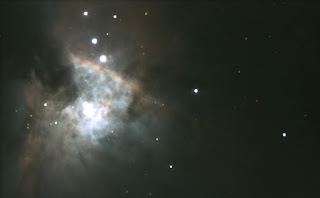I've just added some new capabilities to the Observatory. These additions enable wide-field, fast imaging of DSOs.
,
The foundation is the iOptron ZEQ 25. This mount can carry a 28 pound payload, so it is a perfect match of the new scope (it has already proven itself with the VRC 6). In use, I've found it very easy to polar align, with GOTOs that put the imaged object on the imaging chip 100% of the time. The tracking is superb--I've used 2-3 minute unguided exposures and achieved round stars (though a breeze will cause problems). All in all, it's a great, relatively low-cost mount and it works perfectly with the Newt.
 |
| Mallicam VRC 6, IOptron ZEQ 25, MC JrPro |
The Ritchey-Chretien VRC 6 and the F/4 Newtonian astrographs are great additions to the observatory. They produce superb images that rival those of fine apochromatic refractors at a fraction of the price. Mallincam's excellent QC ensures that the optics are truly diffraction-limited and the scopes arrive perfectly collimated.
 |
The Mallincam Newt F/4, iOptron ZEQ 25 and the DS 2.3+ imaging M42
|
The Mallincam DS 2.3+ is a 1920 x 1080 Class 0 Scientific Grade CMOS imager. It offers a really compelling combination of decent resolution and sensitivity. Earlier blog posts show just how well it performs with very short integration times.
I'm very happy with the capabilities both the VRC 6 and the Newt have added to the observatory. I just hope the weather clears soon so I can get back out with them!



















